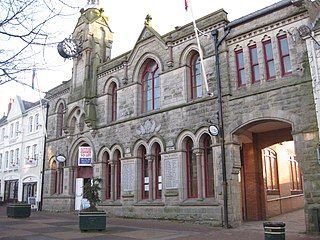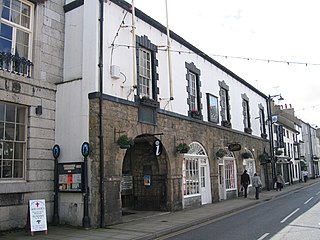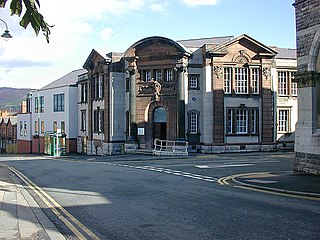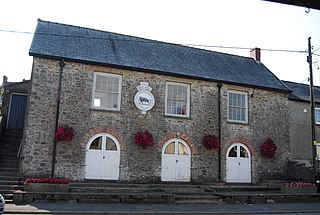
Ruthin Town Hall is a municipal facility in Market Street, Ruthin, Denbighshire, Wales. It is a Grade II listed building.

Holywell Town Hall is a municipal structure in the High Street in Holywell, Wales. The façade of the town hall, which is the only surviving part of the original structure, is a Grade II listed building.

Beaumaris Town Hall is a municipal building on Castle Street, in Beaumaris, Anglesey, Wales. The structure, which is the meeting place of Beaumaris Town Council, is a Grade II listed building.

Laugharne Town Hall is a municipal building in Market Street in Laugharne, Carmarthenshire, Wales. The structure, which is the meeting place of Laugharne Corporation, is a Grade II* listed building.

Llandovery Town Hall is a municipal building in Market Street, Llandovery in Carmarthenshire, Wales. The structure, which is used as the local public library, is a Grade II listed building.

Narberth Town Hall is a municipal building in the High Street, Narberth, Pembrokeshire, Wales. The structure, which is currently used as a shop, is a Grade II listed building.

Denbigh Town Hall, is a municipal building in Crown Lane, Denbigh, Denbighshire, Wales. The structure, which is the meeting place of Denbigh Town Council, is a Grade II* listed building.

Bala Town Hall, known in the late 19th century as the County Hall, is a municipal building in Bala, Gwynedd, Wales. The structure, which is now used as a restaurant, is a Grade II listed building.

County Hall is a municipal building in Wynnstay Road, Ruthin, Denbighshire, Wales. The structure is the headquarters of Denbighshire County Council.

The Old Town Hall is a municipal building in Temple Street, Llandrindod Wells, Powys, Wales. The structure, which accommodates the offices of Llandrindod Wells Town Council, is a Grade II listed building.

Grosmont Town Hall is a municipal building in Grosmont, Monmouthshire, Wales. The structure, which is the meeting place of Grosmont Community Council, is a Grade II listed building.

The Old Town Hall is a municipal building in Old Market Street, Usk, Monmouthshire, Wales. The structure, used as the local club of the Royal British Legion, is a Grade II listed building.

Crickhowell Market Hall, formerly Crickhowell Town Hall, is a municipal building in the High Street, Crickhowell, Powys, Wales. The structure, which accommodates market stalls on the ground floor and a café on the first floor, is a Grade II* listed building.

Talgarth Town Hall, is a municipal building on The Bank, Talgarth, Powys, Wales. The structure, which is the meeting place of Talgarth Town Council, is a Grade II listed building.

The Cheese Market in Hay-on-Wye, formerly Hay-on-Wye Town Hall,, is a municipal building in Market Street, Hay-on-Wye, Powys, Wales. The structure, which has been restored with support from the Heritage Lottery Fund so that the first floor can be let out for residential use, is a Grade II listed building.

Crieff Town Hall is a municipal building in the High Street, Crieff, Perth and Kinross, Scotland. The structure, which currently accommodates the Crieff and Strathearn Museum, is a Category B listed building.

Kidwelly Town Hall is a municipal building in Lady Street, Kidwelly, Carmarthenshire, Wales. The structure, which was last used as a public library but is currently vacant, is a Grade II listed building.

St Clears Town Hall is a municipal building in the High Street, St Clears, Carmarthenshire, Wales. The structure, which is currently disused, is a Grade II listed building.

The Old Town Hall is a former municipal building in Castle Street in Loughor, a town in Swansea, Wales. The structure, which used to be the meeting place of the local borough council, is a Grade II listed building.

The Old Shire Hall is a former judicial building in the High Street in Cardigan, Ceredigion, Wales. The structure, which is now used as a British Red Cross shop, is a Grade II* listed building.






















